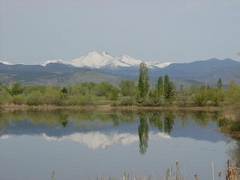
Like the Highlandlake community northeast of Longmont, Ryssby was significant enough in the very early 1900's to have their own regular section in the Longmont newspaper. The settlement was originally founded in 1869 by Sven Johnson, a steamship agent from Ryssby in the southern Swedish province of Smaland. Johnson brought a dozen families from Sweden and they proceeded to make the land suitable for farming by clearing rocks and building irrigation facilities.
After a few very poor years of farming due to drought, locusts, and floods, things improved to where the community applied to the Lutheran Church for a pastor. The Reverend Frederick Lagerman arrived in 1877 (the nearby Lagerman Reservoir is named after him) but he left four years later in a disagreement.
Even with no pastor, the Ryssby community laid the cornerstone to their church on October 31, 1881 which was modeled after a similar one back in Sweden. It was finished eight months later, and a celebration was held on June 24, 1882 which was Midsummer Day on the Nordic Calendar (a festivity in commemoration of the solstice). The church did get another pastor in 1883 when the Reverend L. J. Sandeen arrived. By the late 1880's, about fifty families were in the Ryssby area.
What happened to the Ryssby settlement? As the community prospered, they spread out further from Ryssby to continue their farming. Families began joining the larger Elim Swedish Church in Longmont, slowly draining the Ryssby congregation, and by 1905, the church was deserted. In 1914, the Ryssby Church officially combined with the Elim to form the First Lutheran Church in Longmont.
After a period of neglect and wear, including losing its bell tower to lightning, the Longmont Lutheran community took interest in restoring the church in 1924, led by Pastor Luther Stromquist. The church became a Colorado Historic Site in 1933, and in 1984, was named as a National Historic Site by the Department of the Interior.

Today, the church is used for a few annual celebrations in the summer and Christmas, and also for private functions. And just this year (2008), the Longmont Geneological Society did some outstanding work in researching the cemetery behind the church.
Most of the information here is from the great "Ghosts of the Colorado Plains" (1986) book by Perry Eberhart.

 One citizen's view of Longmont, Colorado, USA.
One citizen's view of Longmont, Colorado, USA.

No comments:
Post a Comment